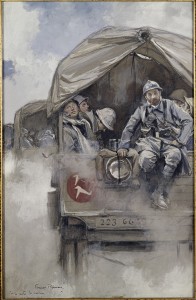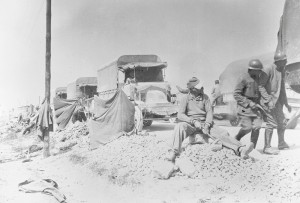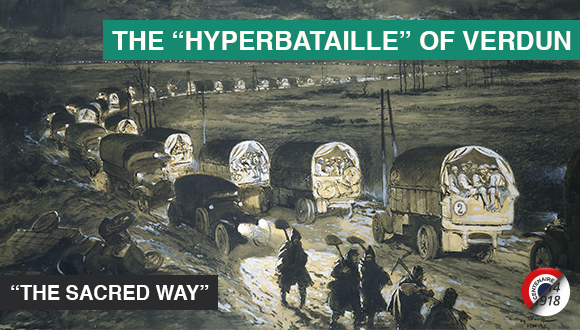 By choosing Verdun, the German General Staff had thoroughly studied the sector and taken into consideration the complete isolation of the encircled city ; its railway network either cut or under a constant artillery fire rendering it impossible to be utilised for munitioning the French forces in action. The only communication axis for delivering to the French army the needed supplies, rations and equipment was the small departmental road between Verdun and Bar-le-Duc.
By choosing Verdun, the German General Staff had thoroughly studied the sector and taken into consideration the complete isolation of the encircled city ; its railway network either cut or under a constant artillery fire rendering it impossible to be utilised for munitioning the French forces in action. The only communication axis for delivering to the French army the needed supplies, rations and equipment was the small departmental road between Verdun and Bar-le-Duc.
 A system of quick rotation had to be introduced to respond to the needs of the front lines. A so-called «Noria» system transformed the road into a sort of «railway road» with its uninterrupted stream of vehicles transporting between 12,000 to 15,000 men and 15,000 tons of food supplies and ammunitions daily. In order to avoid any disruption or slowdown, each vehicle breaking down was promptly pushed to the side of the road. Over 10,000 men were responsible for the ongoing care of the road by continuously shovelling rocks on its surface, under the wheels of each passing vehicle. In a 10 month-period, 900,000 tons of rocks were used.
A system of quick rotation had to be introduced to respond to the needs of the front lines. A so-called «Noria» system transformed the road into a sort of «railway road» with its uninterrupted stream of vehicles transporting between 12,000 to 15,000 men and 15,000 tons of food supplies and ammunitions daily. In order to avoid any disruption or slowdown, each vehicle breaking down was promptly pushed to the side of the road. Over 10,000 men were responsible for the ongoing care of the road by continuously shovelling rocks on its surface, under the wheels of each passing vehicle. In a 10 month-period, 900,000 tons of rocks were used.
 In April 1916, French writer Maurice Barrès surnamed the battle’s umbilical cord «The Sacred Way». The little road was used by two thirds of the French army… even though a small part of the Forces was concurrently routed by the narrow-gauge single track railway called «The Meusien», running parallel to the roadside. In June 1916, the construction of new tracks permitted to connect Verdun to the rear, thus rendering this communication axis less vital.
In April 1916, French writer Maurice Barrès surnamed the battle’s umbilical cord «The Sacred Way». The little road was used by two thirds of the French army… even though a small part of the Forces was concurrently routed by the narrow-gauge single track railway called «The Meusien», running parallel to the roadside. In June 1916, the construction of new tracks permitted to connect Verdun to the rear, thus rendering this communication axis less vital.


Ajouter un commentaire